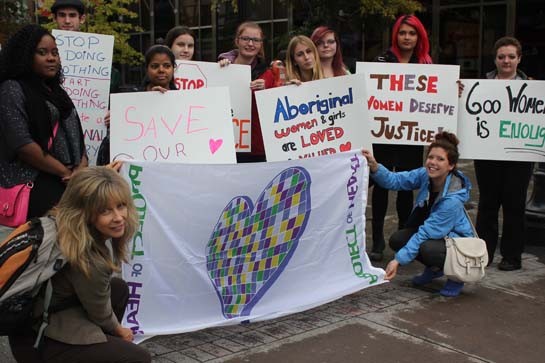Sylvia Smith, an alternative high school teacher in Ottawa, never dreamed a buried episode in Canadian history would come to light as she was teaching Grade 10 history seven years ago. It all began when the class was reading the very few words in their textbook dedicated to Indian residential schools. One student decided to research more on the topic. "Her interest was contagious," Smith recalls. "My own interest was piqued as well. This was an opportunity to learn something we hadn't known."
Starting in the late 19th century, 250 residential schools for Canada's Aboriginal children were established, more than half of them by the federal government. Smith's students learned how First Nations children were forcibly removed from their homes and put in these schools to "kill the Indian in the child," by isolating them from their families and culture. Many of the children also suffered physical, emotional and sexual abuse at the schools. "A guest speaker who was a residential school survivor came in," Smith says, "and this especially deepened our knowledge."
Smith and her students also learned that at some schools, the death rate ranged from 24 per cent to 75 per cent, due to disease, malnutrition and other forms of abuse and neglect. "When we found out so many died, a lot of my students were very angry," Smith says.
Peter Bryce, the medical inspector for the federal government, had been sent to investigate the health and safety of students in 1907. He concluded residential schools were "a national crime." The government chose not to take action after hearing Bryce's report and he was demoted and eventually fired. "He's one of our heroes," Smith says.
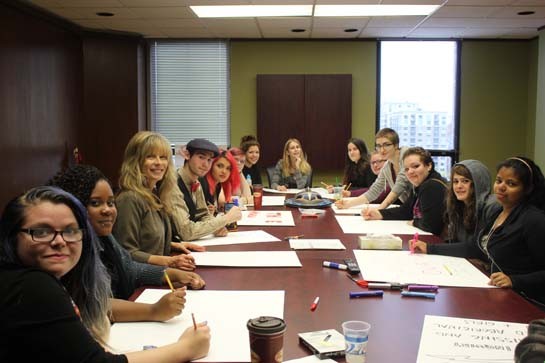
The students in Sylvia Smith’s class made posters to take to the Sisters in Spirit Vigil on Parliament Hill. PHOTOGRAPH: COURTESY NATIVE WOMEN’S ASSOCIATION OF CANADA
HIDDEN TRUTHS AND BROKEN HEARTS
Smith realized most Canadians had not been taught about this history. Nor had many Aboriginal youth, since their elders had felt too much pain and shame to pass on their residential schooling experiences. The impact of their treatment continues to fracture First Nations, Métis and Inuit communities today.
After learning about these hidden truths, Smith developed "Project of Heart," a kit with a lesson package on the history of residential schools. "The Truth and Reconciliation Commission had just started," Smith recalls, "and so the timing of Project of Heart seemed just right." Inspired by South Africa's Truth and Reconciliation Commission, instituted as a form of restorative justice after apartheid had ended, Canada's commission is part of a response to the legacy of residential schools as set out in the Indian Residential Schools Settlement Agreement, reached in May 2006.
Project of Heart's first lesson requires each student to research a residential school. This research is carried out in conjunction with classroom lessons on the wider context of the history of the schools, government policies, and the First Nations themselves. "Students learn about the First Nation on whose territory the school was built," says Smith. Why is this step important? "Because," she says, "it helps students see Aboriginal peoples through a lens of agency and resilience — to understand the largely hidden history of the contributions Indigenous peoples have made to this country." Next, students create an image on a wooden tile. Tiles painted with black edges symbolize students who died in residential schools. Those with coloured edges indicate school survivors. All completed tiles are collected to create a larger artwork.
A residential school survivor is then invited into the classroom to share his or her experiences.
PASSION IN ACTION
The project concludes, Smith says, with a call to action. Students learn about a justice issue affecting Indigenous communities, such as the need for better housing or clean water, and address it. The purpose? To help change policies that continue to harm Aboriginal people in Canada. "Now we must begin earning their trust," Smith says of this final lesson. "We must walk the talk."
For this remarkable grassroots educational initiative, Smith was awarded a Governor General's History Award for Excellence in Teaching.
As more teachers across Canada learned about the project, and teachers' unions gave their support, Smith said, the demand for Project of Heart kits became overwhelming. "I was working on putting kits together all weekend," she says. "I was getting very little sleep. In 2011, I asked for help. I thought the project was almost finished." That's when Charlene Bearhead, a former teacher, principal and superintendent in Alberta, stepped in. "This is just getting started," she told Smith.
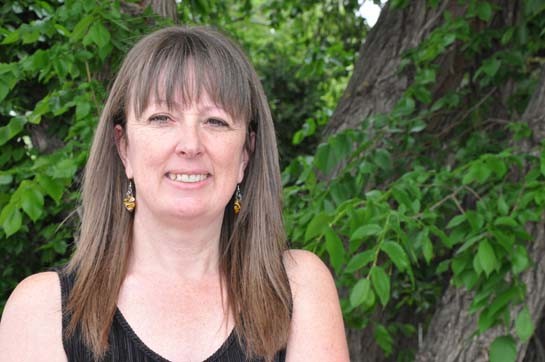
Charlene Bearhead Photograph: Lese Skidmore/bearpaw Media Productions
Bearhead had the expertise and passion to take Project of Heart to the next level. She is the program director for the National Day of Healing and Reconciliation, at Native Counselling Services of Alberta, in Edmonton. It's the umbrella for Project of Heart, which had its federal funding cancelled by the Conservative government in March 2013. Still, she says, hundreds of public, private and religious schools across Canada have taught, and continue to teach, Project of Heart. "We've put the project online, and our goal is to make it sustainable."
Youth groups, church groups, treatment centres, corrections facilities and families have also participated. "It's also been taught in New Zealand, with the Maori people," Bearhead says.
SO MANY CHILDREN DIED
As the Aboriginal community takes ownership of the project, Bearhead is clear these lessons aren't solely "Aboriginal history" for Aboriginal people. "It's Canadian history," she says.
When survivors come into classrooms and talk about their experiences, they also may reflect on how they are revitalized themselves. "It's a really important part of social justice," Bearhead says. "We don't want to shame or re-traumatize them."
Many residential schools boarded students, with children coming far from home. They had regular classes, but, in some schools, students also cleaned, cooked, sewed, did laundry and worked in the gardens. "When learning about residential schools, one of the most difficult things to learn is how many children died," Bearhead observes. "Some died in industrial accidents. The students were free labour."
Teachers' attendance records were set up with three additional columns: "good, sick and dead."
"Many were beaten," Bearhead says. "Many others starved, froze or drowned while running away." Children also died of tuberculosis, Spanish flu, in fires or by suicide.
Churches were contracted by the federal government to operate a portion of the residential schools and have also been held culpable for what happened. In this phase of Project of Heart, as part of the reconciliation efforts, the Anglican Church and United Church have paid for tiles and website support.
ABORIGINAL ARTISTS AND THE ART OF STUDENTS
Permanent exhibits by Aboriginal artists using participants' project tiles are in various stages of completion across Canada. Sylvia Smith has collected 50,000 tiles and is in conversation with possible national museum hosts for a permanent exhibit. An additional 80,000 tiles will be incorporated into permanent exhibits in every province and territory in the country. An 18-foot racing canoe, covered with 9,000 tiles given by B.C. students, was unveiled in Vancouver to open the Truth and Reconciliation events in September 2013. The cedar canoe was carved by Kiapalanexw (Derrick George), of the Tsleil-Waututh Nation, and his sons. Working with him was designer Una Ann Moyer, of the Tahltan Nation.
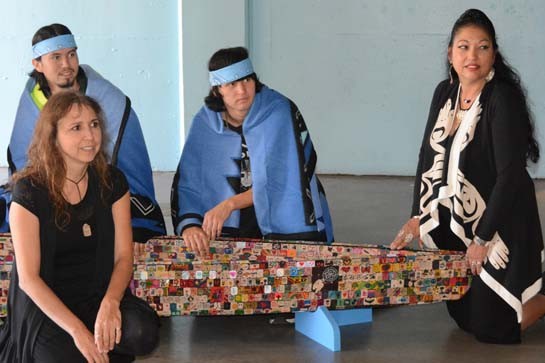
With The Tsleil-waututh Racing Canoe Built From Over 9,000 Project Of Heart Tiles, (left To Right) Gail Stromquist, Two Sons Of Kiapalanexw (derrick George) And Una Ann Moyer Photograph: Susan Croll/bctf
Teachers and students have extended the project lessons, Bearhead says, with activities such as creating videos and songs about what they have learned. Several of these initiatives are posted on the Project of Heart website.
Bearhead would like to see this history taught as part of the regular curriculum, from kindergarten to university. For now, collaboration is going on across Canada to spread the project. Some of the Atlantic provincial education ministries, for example, are partnering with Indian Residential School Societies to incorporate the lessons in schools.
Bearhead praises the BC Teachers' Federation (BCTF) and its 70 local union presidents. "They are all personally promoting the project and they all took the training," she says. "It's the union, not the government, doing their own training. B.C. has been the most successful at grassroots work, because of the Aboriginal and social justice component (within the union)."
SUSTAINABLE SPIRIT
The project will become sustainable, Bearhead believes, as teachers take ownership, like they have already in B.C., and begin teaching about residential schools, independent of Project of Heart. "Terminating funding can't stop us when there is a total commitment of the teachers," she says.
Canadians of both Aboriginal and non-Aboriginal backgrounds once had positive relationships, Bearhead says, pointing to the legacy of the Métis, a Canadian people of European and Aboriginal heritage. "This was destroyed when the French and English governments came into the picture.
"This affects all of us," Bearhead says, "because of the mistrust and misinformation created by governments. If we share and acknowledge the truth, we can find the way forward and have positive relationships." Project of Heart, as its name implies, influences students on many levels. "We can forget the 'intellectual' side of what we learn," Bearhead observes, "but we can't unfeel what we feel."
* * * * * *
At Brookswood Secondary School in Langley, B.C., Grade 8 students listen intently to Mercy Thomas, a survivor of the schools. At some level there is no healing for the survivors, Mercy Thomas tells them. "We will go to our graves carrying this hurt. There is not enough money in the world to buy away the hurt, shame, humiliation, loss of identity, and near annihilation of Aboriginal culture. It was nearly genocide."
Students' heads nod around the classroom as one girl says: "It's hard to think that these really bad things happened right here in Canada. We're not perfect, like some people think we are."
— excerpt from BC Teacher newsmagazine (Nancy Knickerbocker, September 2013
* * * * * *
These are Larry Goldsack's students, listening to Mercy Thomas describe her experiences as a residential school survivor. When he was preparing for his Social Studies classes last year, Goldsack wondered if teaching Project of Heart could be "too much" for his Grade 8 students. He decided to give it a try. Besides, First Nations history is a passion for him. His wife is of Aboriginal heritage, as are his two grown children. "I didn't hold any punches," he says of the experience. "The kids were amazing."
Before he began the project, Goldsack sent home letters to his students' parents, to let them know he was teaching a sensitive and emotional topic. He said once he started teaching the project, he learned his students were talking to their parents about it. "The parents later said to me, 'How come we didn't learn this?'"
Goldsack said his students were most upset about the fact that the government didn't step in when they learned so many children at the schools were dying. "There were 50,000 missing children. Where did they go? The kids couldn't wrap their heads around it," Goldsack says.
CANADIANS DID NOT ACT
"When we consider the 'bystanders,'" he says — those Canadians who stood by and did not act — "the conversation gets bigger."
It always comes as a surprise to learn that the last residential school closed only in 1996, which is not that long ago, Goldsack adds.
He said when Mercy Thomas was invited to speak, his students were prepared. "I was impressed by the depth of their thoughts, their comments, maturity and understanding," he says proudly. "It helps people to heal when other people understand. My Grade 8s got it."
Goldsack says his teaching approach isn't to shock, lay blame or express anger. "We need to know this history," he says. "This has been suppressed. We need to help survivors cope with what happened." Residential school survivors will eventually all be gone and these stories could become lost, Goldsack says. This makes the timing for teaching this long-overdue history even more significant.

Students With Their Project Of Heart Tiles. Photograph: Courtesy Jane Brundige
Goldsack observes that some teachers are reluctant to take on these lessons. "They say they don't know enough to teach about residential schools." He says the BCTF workshops are there to say, "That's okay." "People have to talk. You don't have to teach everything. You can start small." This school year Goldsack will be teaching Project of Heart to his students once again, beginning his first lesson on Valentine's Day.
100 YEARS OF LOSS
"We cannot stand still," says Gail Stromquist, the Aboriginal education co-ordinator at the BC Teachers' Federation. She has been working in overdrive to spread the word on Project of Heart and a second project on the same topic called "100 Years of Loss," developed by the Legacy of Hope Foundation. In one weekend alone last October, Stromquist says 800 BC teachers took workshops to learn about the residential schooling experience.
"Every local is linked with a Project of Heart website," Stromquist says. "Tiles have been shipped to 250 schools. The Legacy of Hope kit is available in each local, too, and it contains a foldable timeline and other related materials. We gain understanding," Stromquist believes, "by sharing our history and the legacy of residential schools. A lot of work is being done."
Besides facilitating the distribution of resources and teacher training, the BCTF administered a $100,000 grant to allow teachers around the province to travel to the Truth and Reconciliation events in Vancouver this past September. "The monies were completely used," Stromquist says.
"We have advocated to have this mandatory for the school curriculum and in teacher education programs. It will be the way to educate future leaders and it gives everyone a better understanding of history."
Stromquist has been exposed to the powerful feedback of the project, through her work and personal connection to this history. "People are finally starting to really hear and understand and learn and people want to know more," she says. "People are saying, 'I lived in a community with a residential school. I never knew anything.'" That's because what was going on was "purposely hidden,"
Stromquist says. "Since then, there has been a silence. There has been fear and shame. We didn't share with each other. The experiences have started to come out at these Truth and Reconciliation events. Survivors are opening up and are more comfortable."
HEALING CIRCLES KEEP HISTORY ALIVE
Stromquist gives the example of two brothers on Kuper Island. They were in a healing circle recently and, for the first time, talked about their experiences at residential schools. "My dad's two sisters both died at residential schools," Stromquist says. "The family didn't talk about it. It was too painful." Stromquist says one of her aunts died of pneumonia and the other aunt died of tuberculosis. "We don't want this swept under the carpet. It's really important to keep this history alive."
Christina Johns, an elementary school teacher, has just completed a term position as a teacher trainer, working with First Nations and Métis student teachers at the Gabriel Dumont Institute in Regina, Saskatchewan. "Students were learning how to take Project of Heart and create lesson plans for their practicums," Johns says. "They expanded on the project by designing lessons about reflecting, researching, writing poetry and creating other
art forms."
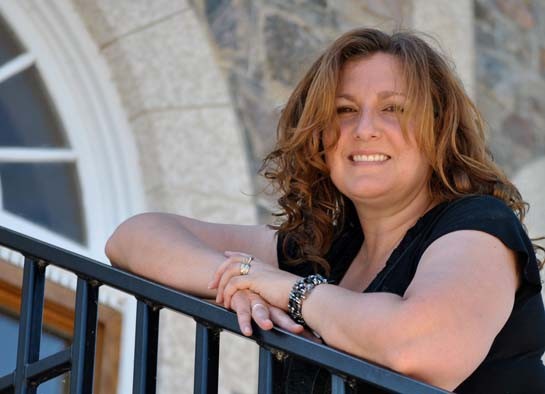
Christina Johns Photograph: Brittany Johns
The campus is part of the Saskatchewan Urban Native Teacher Education Program (SUNTEP), which has a mandate to teach anti-oppressive education. Johns says the project fit perfectly with this curriculum. She also believes the project is part of "shared history" and meant for all Canadians to learn, just as she says Treaty history is shared history.
THE LAST GENERATION
When her students presented their lesson ideas to the class, "it was emotional," Johns says. "The lessons involved interviewing parents and grandparents. They have a connection to this history." Many of her students had never heard the stories before. The lessons they designed were deeper than Johns anticipated. They went "to a hard place," she observes.
Johns also created a tile alongside her students, after gathering her family together and talking to her mother, who went to residential school, as well as to her maternal aunt and her own daughter. "We were three generations," Johns says. "I heard stories I had never heard. I listened to the stories and then I decorated a tile."
She says these experiences of telling and listening are different for everyone. "It's a raw subject. There is still so much hurt and anger." Yet, Johns says, this is part of the process of healing. "This is a good time to do this," she says. "This is the last generation. They still have stories."
Janet Nicol is a Vancouver-based freelance writer and regular blogger.


